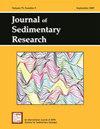用新西兰奥特亚罗瓦省 Kaikōura 地震共震事件床测试浊积岩概念模型
IF 2
4区 地球科学
Q1 GEOLOGY
引用次数: 0
摘要
2016 年新西兰奥特亚罗瓦 Mw7.8 级 Kaikōura 地震为测试广泛应用的浊积岩沉积模型提供了机会,因为地震引发了同震浊流。由此产生的被解释为浊积岩的 Kaikōura 事件海床(KEB)沿沉积系统向下取样约 1300 公里。利用沉积岩芯岩性、计算机断层扫描(CT)和粒度数据,对照 Bouma(1962 年)的浊积岩概念模型,测试了事件床的厚度、粉砂含量、岩相分布和堆积模式。KEB 厚度在下流距约 100 公里处可变,在下流距约 700 公里处达到最大厚度,然后向远端变薄,与预测的钟形近端到远端趋势相似。整个 KEB 从峡谷到扇形区域的淤泥含量都很高。KEB以层状的Td面和Te面为主,这些面从层状向下系统演化,然后分级,最后变成均质泥浆。CT 和粒度测量数据是区分细粒沉积物中细微密度和纹理变化的关键,它们揭示了 KEB 中的 Td 和 Te 层,而这些层在较早的沉积物中往往无法保存或不易观察到。KEB 凸显了一种细粒沉积系统,与研究较多的砂质浊积岩盆地形成鲜明对比。特别是,KEB 的实例揭示了 Td 和 Te 层在这种富含粉砂的细粒系统中无处不在。根据 KEB 开发的各种概念模型可能适用于许多现代深海浊积岩系统,对于理解当今向深海的颗粒运移和解释地层记录中的证据至关重要。本文章由计算机程序翻译,如有差异,请以英文原文为准。
Testing turbidite conceptual models with the Kaikōura Earthquake co-seismic event bed, Aotearoa New Zealand
The 2016 Mw7.8 Kaikōura Earthquake in Aotearoa New Zealand provides an opportunity to test widely applied turbidite sedimentation models because it triggered a co-seismic turbidity current. The resultant Kaikōura event bed (KEB), interpreted as a turbidite, is sampled for approx. 1300-km down-flow along the depositional system. Sediment core lithologies, computed tomography (CT), and particle-size data are used to test event-bed thickness, silt content, facies distribution and stacking patterns against the foundations of the turbidite conceptual model of Bouma (1962). KEB thickness is variable to approx. 100 km down-flow distance and attains a maximum thickness at approx. 700 km down-flow distance before thinning distally, similar to the predicted bell-shaped proximal to distal trend. Silt content is high throughout the KEB from canyon to fan. The KEB is dominated by laminated Td facies and Te facies that evolve down-system from laminated, then graded, to homogenous muds. CT and granulometry data ar e key to differentiating subtle density and textural variations within fine-grained deposits and reveal that KEB Td and Te facies in the KEB that are often not preserved or readily observed in older deposits. The KEB highlights a fine-grained sedimentary system that contrasts with more widely studied sandy turbidite basins. In particular, the KEB example reveals that Td and Te facies are ubiquitous in this fine-grained, silt-rich system. A varied conceptual model developed from the KEB may be applicable to many modern deep-sea turbidite systems and crucial for understanding present-day particulate transport to the deep sea and interpreting evidence from the stratigraphic record.
求助全文
通过发布文献求助,成功后即可免费获取论文全文。
去求助
来源期刊
CiteScore
3.80
自引率
5.00%
发文量
50
审稿时长
3 months
期刊介绍:
The journal is broad and international in scope and welcomes contributions that further the fundamental understanding of sedimentary processes, the origin of sedimentary deposits, the workings of sedimentary systems, and the records of earth history contained within sedimentary rocks.

 求助内容:
求助内容: 应助结果提醒方式:
应助结果提醒方式:


